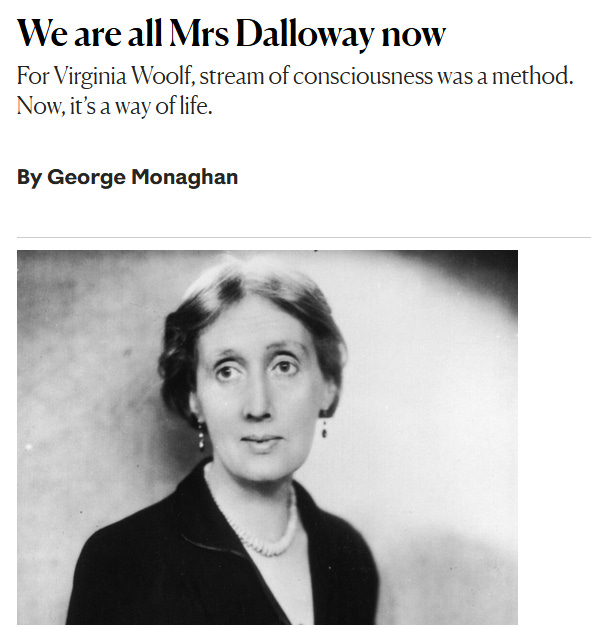It’s Dalloway week mothafockas and you know what that means… I have written about young straight male novelists and am pleased it was picked up by RealClearBooks and the Washington Review of Books.
No — well yes, I did do that and the next issue here will follow up on it — but today is about Virginia Woolf. It came out in the NS on Wednesday and became my second best-performing article. I hope you like it and best wishes from Leicestershire!
Everyone has cracks; we hear that’s how the light gets in. Adeline Virginia Stephen wanted a life flooded with light. Marrying her husband, Leonard Woolf, in 1912, she said she wanted “everything – love, children, adventure, intimacy, work”. In her masterpiece Mrs Dalloway, published a century ago, she wanted “all inner feelings to be lit up”. But so much light meant so many cracks.
Virginia Woolf is now such a large figure in global literary culture that she has at least 15 full-length biographies. But Mark Hussey’s new Mrs Dalloway is a biography of a novel by Woolf, relaying its conception, execution and propagation. Hussey is Professor of English at New York’s Pace University, and we believe him when he tells us Woolf is “my favourite writer”: he has published several books on her, and includes a charmingly domestic photo of his personal Dalloway stash, piled 20 editions high, which he started over 50 years ago.
By scholarship’s best guess, Dalloway’s scene – “life; London; this moment of June” – is 11 June 1923. For the last eight years, with Woolf’s reputation higher than ever, a “Dalloway Day” has been celebrated, with tours of Woolf’s London led by the Virginia Woolf Society. The festivities will be particularly exuberant this year, the centenary of Dalloway’s publication. Walkers will see Bloomsbury and Westminster in all the “absorbing, mysterious… infinite richness” Woolf imbued them with, “as if in the presence of some sacred ceremony to interrupt which would have been impious”.
The amusements may sound little more than a short walk around central London. But so, really, might the book’s plot. In the story, a politician’s fashionable wife, Clarissa Dalloway, gives a fancy party, and a traumatised young veteran of the First World War, Septimus Warren Smith, kills himself after his doctors neglect him. Hussey is correct that, asked what the book is about, one might answer “not much.”
But, of course, for Woolf it was all about what was happening inside her characters. In that way she was of her modernist cohort, trying to find her artistic bearings after the moment “on or about December 1910”, as she put it, when “human character changed”. To Woolf, to Joyce, to Proust, there had been what Hussey calls “a fundamental shift in relations” between subject, object, and the nature of reality. What Woolf called Edwardian writing was futile just as describing a house’s exterior was futile to convey the soul who slept inside. If art was to answer the “astonishing disorder” of modernity, it had to directly penetrate conscious experience.
It was an ambitious project, but Woolf felt confident. She had brought off two fairly conventional novels, and her more daring third, Jacob’s Room, had attained wide praise. She felt she could write freely, and that she at last knew “how to begin (at 40) to say something in my own voice”. Or, putting it another way, that she was “beginning to learn the mechanism of my own brain”.
Her voice was her mental mechanism, however flawed that mechanism. Woolf had had to stay in a private nursing home after a severe breakdown that came a year after the marriage from which she wanted everything. A few months later, chance alone her saved her from death, after she took a deliberate overdose of Veronal (a sleeping aid). And two years after that she had suffered another severe breakdown. But with her confidence and reputation waxing, she felt “madness is terrific… in its lava I find most of the things I write about”.
Readers liked in her what she liked in those she read: what she called “queer individuality”. So the project was to inspect her self as it shattered and reconstituted. No humans were “as they used to hold, immaculate, monolithic, consistent wholes”. Instead they were “splinters & mosaics”, and art should show them as such. A plane broken to pieces and put together again became a mosaic, and thereby turned particular, beautiful, and more interestingly refractive. At one point in the novel, Clarissa Dalloway is seen mending her dress.
To do full justice to her “queer individuality”, she devised for Mrs Dalloway a “queer & masterful” design. For it, she had “almost too many ideas. I want to give life & death, sanity & insanity.” So she devised Clarissa Dalloway and Septimus Warren Smith, who would show “the world seen by the sane & the insane side by side” and who, as in a long-held idea for a play, would only ever “almost meet – only a door between – you see how they just miss – and go off at a tangent, and never come anywhere near again”.
But they did come near again. The problem we all know, visible in the book and its author’s life, is that the separation did not hold. Sanity went into insanity, life went into death. In 1941, Woolf drowned herself in the River Ouse. Clarissa does not commit suicide, but was originally intended to, and it may be telling that one early reader mistakenly believed she had after finishing the book. Septimus, a shell-shocked veteran of the First World War, who fought to defend Shakespeare’s England, does kill himself, and gives lie to the vision of art as individualisation.
If the war launched Woolf’s project, it also undermined it. Compare Woolf’s artistic vision of splinters and mosaics, of lively Clarissa mending her dress, with her thoughts when visiting a relative, wounded during the First World War, in his hospital ward. She felt “the uselessness of it all, breaking these people & mending them again”. It is hard to say what differentiates life-giving art from death-giving war. In one letter, Woolf described the War in artistic terms, as “the preposterous masculine fiction”. Septimus is a traumatised veteran, but if any character has “queer individuality” it is he. And he grows “stranger and stranger”, more and more alone, by allowing himself to think too much.
The modernists thought leaving “description” for “insight” would help them ascertain truth; in fact it destroyed it. They were not writing, as they thought, after Einstein and Freud, but after their closer contemporary, Werner Heisenberg, the quantum physicist who found that electrons refused to be fixed under observation. So did the modern self, inspection only creating uncertainty. Woolf was closer than she knew on writing in her essay “Modern Novels” that consciousness is an “incessant shower of innumerable atoms”. The self-attention they hoped would achieve stability in fact wrecks it. The more you look, the less you know…
I hope you click through and that you enjoy that team. It was great to see it get enough traffic to briefly place me among three of my favourite living writers:
And I was grateful to the Manchester University Press for their support:
If you fancy, please buy both the New Statesman and the Times Literary Supplement which come out on Friday.









Really enjoyed this one, too. Thank you for sharing 🤓 … and I thought I was a Woolf nerd. I have nothing on this man.